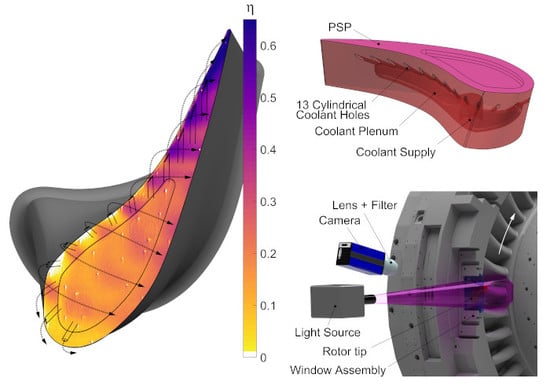Experimental Investigation of Rotor Tip Film Cooling at an Axial Turbine with Swirling Inflow Using Pressure Sensitive Paint †
Abstract
1. Introduction
1.1. Motivation
1.2. Scope of This Work
1.3. Effects of Turbulence
1.4. Effects of Incidence Angle
2. Experimental Setup
2.1. The Large Scale Turbine Rig
2.2. Rotor Tips
2.3. Tip Coolant Supply
2.4. Effect of Swirl on Rotor Tip Flow Field
3. Experimental Method
- Adiabatic Effectiveness Assuming low conductivity blade materials, the adiabatic film cooling effectiveness can be defined using the temperatures of the main flow , the coolant , and the adiabatic wall (Equation (1)-I).
- General Mass Transfer Analogy for Film Cooling The analogy between heat and mass transfer can be applied if the flow is (1) turbulent, so that the ratio of turbulent thermal diffusivity to turbulent mass diffusivity is around unity (), and (2) if the flow is low-speed (), so that the viscous energy dissipation and the influence of pressure gradients can be neglected in the boundary layer energy equation [12]. Both conditions are usually met in a low-speed turbine rig. Appropriately, can be defined using a tracer element that is present with concentrations in the mainstream, in the coolant, and near the wall (Equation (1)-II).
- PSP Mass Transfer Analogy for Film Cooling To isolate the pressure response of the paint from the concentration response, two separate experiments are carried out.
- Air injected as coolant: The oxygen concentration of the coolant is the same as in the main stream. In this way, the underlying pressure distribution caused by the main flow and the coolant injection is accounted for. The resulting emission intensity is and the corresponding oxygen partial pressure and concentration fields are and (Equation (1)-III).
- Foreign gas injected as coolant: The paint responds to the oxygen concentration distribution resulting from the mixing between the oxygen-free coolant and main flow. The resulting emission intensity is and the corresponding oxygen partial pressure and concentration fields are and . Carbon dioxide was used as foreign gas () to achieve a coolant-to-mainstream density ratio of 1.5.
- Conversion between Pressure and Intensity For this investigation, an intensity-based PSP method is used as described by Liu and Sullivan [14]. During the experiments, the paint emission intensity is recorded by the camera for a fixed exposure time. Afterwards, the relationship between the recorded intensity and pressure is established via a calibration.
- Experiment: As described in III, two experiments are conducted resulting in the intensities and . A reference image is taken right after the experiments when the rig is turned off. The temperature change between experiment and reference image is monitored and taken into account during calibration. In addition, a dark image is taken to account for the dark noise of the camera.
- Calibration: A specimen that has been painted simultaneously to the blade tip is placed in a calibration chamber based on a design by Bitter [15]. The chamber pressure is controlled by a pressure controller (PPC4 A160KS by Fluke Calibration, Everett, WA, USA) to within ±1 Pa. The specimen temperature is kept constant using a Peltier-heater to within ±0.1 K. A reference image is taken at the same conditions as the reference image for the rig experiment. The chamber pressure is then varied and images are taken at the same temperatures as during the rig experiment. A polynomial curve fit is applied (Equation (2), , , , ) relating the measured intensities to pressures (Figure 4b):
4. Data Acquisition
4.1. PSP Measurements on Rotating Blades
- Phase-Locked Methods based on Paint Lifetime or Intensity: A strobe light synchronized with the rotor is used to excite the paint [16,17]. The once-per revolution signal is collected on the image sensor with an open camera shutter over several hundred revolutions to improve SNR. This method requires high cycle-to-cycle stability and is susceptible to image blur.
- A specific Phase-Locked Method based on Intensity: Here, a synchronized strobe light is used as well [5,18]. However, the image sensor is read out every revolution, thus limiting the collected signal. Several hundred images are captured and averaged, accounting for cycle-to-cycle instabilities in blade movement and excitation intensity.
- Single-Shot Methods based on PSP Lifetime: A laser is used as a high-energy excitation source leading to a high SNR [19,20,21,22]. A double shutter particle image velocimetry (PIV) camera records a set of images with very short exposure times, minimizing the effects of cycle-to-cycle instabilities and blade movement.
4.2. Optical Setup
4.3. Recording Sequence
4.4. Image Transformation
5. Measurement Uncertainty
5.1. Absolute Uncertainty
5.2. Contributors in Calibration
5.3. Contributors in Measurement
5.4. Repeatability
5.5. Resolution
6. Results
6.1. Measurement Matrix
6.2. Axial Inflow Baseline Case
- i
- Leading Edge: Looking towards the LE, cooling holes 1 to 3 are located towards the suction side (SS) and do not directly contribute to the cooling in the measurement area in the case of IR = 0.93% and lower.
- ii
- Pressure Side Rim: Along the PS rim, a pattern can be identified with local maxima and minima in that stems from the discrete coolant jets.
- iii
- Squealer Cavity and Suction Side Rim: Inside the cavity close to the PS, the coolant coverage is quite low. In the region of the camberline, the highest values for inside the cavity are found. Further towards the SS rim, the pattern is extenuated.
- iv
- Trailing Edge: At the TE, no clear pattern is visible in the case of IR = 0.93%. Since the angles of cooling holes 11 to 13 are steep at the TE, the areas of effect of the coolant jets overlap at the tip, resulting in a more uniform distribution of elevated .
6.3. Effect of Swirl in Comparison to Axial Baseline
- i
- Leading Edge: Due to the change in whirl angle, the stagnation point is shifted towards the SS, resulting in an increasing MR of coolant jet 4. Additionally, the flow vector becomes more axial, pushing coolant jet 3 towards the tip surface, and increasing in this area.
- ii
- Pressure Side Rim: The coolant jets along the PS rim are pushed further downstream, which can be seen by a shift in the characteristic pattern on the surface. Coolant jet 8 does not experience the same shift, but stays almost in the same position as before.
- iii
- Squealer Cavity and Suction Side Rim: Similar to the PS rim, the coolant jet pattern is shifted downstream. Overall, the film cooling effectiveness in the squealer area is increased.
- iv
- Trailing Edge: Coolant jets 9 to 13 are shifted upstream towards the center of the blade tip and coolant coverage at the TE is decreased drastically for SW resulting in a decrease in by up to 0.15.
6.4. Effect of Injection Ratio Variation for Axial Inflow
- i
- Leading Edge: At the LE, near the stagnation point, decreases with increasing IR. Near the stagnation point, high values of BR and MR are found. This is due to approaching zero here. For increasing IR, especially MR becomes very large since factors into MR quadratically. At IR = 1.74%, there are no distinct jet traces at the LE. It is concluded that coolant jets 4 and 5 are not attached to the blade surface for this high IR. In contrast, for IR equal to and greater than 0.93%, the SS of the LE is starting to be cooled better. This corresponds to the area affected by jet 3 that gains momentum for higher IR, thus now reaching the rotor tip surface. The traces of jet 1 and 2 cannot be seen on the tip surface for any IR. Considering their MR remains low in all cases, they do not reach the tip surface, thus not contributing to cooling in this area.
- ii
- Pressure Side Rim: The characteristic coolant jet traces along the PS rim become narrower for increasing IR. Two possible reasons are (1) that the jets are less mixed out and (2) that they are not pushed towards the tip surface as much as for low IR. Both correspond to the increase in MR that is visible for increasing IR for jets 6 to 8.
- iii
- Squealer Cavity and Suction Side Rim: Inside the cavity, the characteristic coolant jet pattern starts to disappear for higher IR. This can be explained by the jets lifting off for higher IR, so that the coolant does not reach the blade surface directly, but after mixing with the surrounding flow. This leads to a more uniform coverage, while overall relatively little coolant reaches the blade surface in comparison to the high coolant injection.
- iv
- Trailing Edge: The coolant coverage at the TE increases with increasing IR. For very low IR, coolant jets 9 to 13 have very little momentum and the coolant stays near the PS without being able to cool the TE effectively. As IR is increased and so is MR, the jets have enough momentum to cover the entire TE. Since velocities are higher at the TE, the MR does not increase as much as along the PS rim. This corresponds to the cooling performance being not negatively affected in this area, which can be explained by coolant jets still being attached to the surface.
6.5. Effect of Swirl for Varying Injection Ratios
7. Conclusions
- i
- Using pressure sensitive paint, the spatial film cooling distribution at a squealer tip with cylindrical cooling holes was obtained under rotating conditions. Both axial turbine inflow as well as engine-realistic swirling inflow, resulting in a reduced whirl angle and higher turbulence level at the tip, were investigated.
- ii
- The coolant trajectories are influenced by the whirl angle, the tip leakage flow, and the secondary flow structure around the rotor tip. Due to the swirl, this flow structure changes and in turn affects the local film cooling distribution.
- iii
- For both inlet conditions, film cooling effectiveness increases when the coolant mass flow is increased, however the absolute value of film cooling effectiveness is dependent both on the inlet condition as well as the coolant mass flow. For low injection ratios, film cooling effectiveness is decreased by turbine inlet swirl by up to 26%, while for high injections rates it is increased by up to 11%.
- iv
- For an engine-realistic injection ratio of 0.93%, swirling inflow decreases the film cooling effectiveness by about 0.15 at the trailing edge, even though the total area averaged film cooling effectiveness is the same as for axial inflow for this injection ratio. Assuming a hot gas temperature of 1700 K and a coolant temperature of 900 K, a decrease of 0.15 in film cooling effectiveness corresponds to a significant increase in adiabatic wall temperature by 120 K, which needs to be considered during the design process.
- v
- Beyond a certain point, increasing the coolant mass flow does not further increase cooling effectiveness. This saturation occurs at lower injection ratios for axial inflow and at higher injection ratios for swirling inflow.
Author Contributions
Funding
Acknowledgments
Conflicts of Interest
Abbreviations
| Latin | |
| Stern–Volmer coefficients | |
| blowing ratio | |
| C | concentration, mass fraction |
| c | chord length (mm) |
| c | absolute velocity (m/s) |
| specific heat capacity (J/(kg·K) | |
| pressure coefficient | |
| blade motion (mm) | |
| density ratio | |
| relative channel height (%) | |
| I | intensity (counts) |
| injection ratio | |
| turbulent Lewis number | |
| mass flow (kg/s) | |
| Mach number | |
| momentum flux ratio | |
| pressure (Pa) | |
| R | gas constant air (J/mol) |
| Reynolds number | |
| signal-to-noise ratio | |
| T | temperature (K) |
| tip clearance (%) | |
| u | velocity, circumferential velocity (m/s) |
| u | combined standard uncertainty (according to input) |
| w | rotor relative velocity (m/s) |
| W | molecular weight (kg/kmol) |
| x | axial coordinate (mm) |
| Greek | |
| rotor relative angle (°) | |
| heat capacity ratio | |
| difference | |
| film cooling effectiveness | |
| density (kg/m) | |
| Subscripts | |
| air injection | |
| adiabatic wall | |
| axial | |
| c | coolant |
| dark image | |
| foreign gas | |
| g | gas, main flow |
| inlet | |
| isentropic | |
| averaged | |
| minimum | |
| outlet | |
| oxygen | |
| primary | |
| in radial direction | |
| reference | |
| relative | |
| at the rotor | |
| s | static |
| secondary | |
| at the stator | |
| t | total, stagnation |
| in circumferential direction | |
| ∞ | main flow |
| Abbreviations | |
| axial turbine inflow | |
| computer aided design | |
| charge-coupled device | |
| computational fluid cynamics | |
| leading edge | |
| light emitting diode | |
| Large Scale Turbine Rig | |
| nozzle guide vane | |
| pixel coordinates | |
| particle image velocimetry | |
| pressure side | |
| pressure sensitive paint | |
| rear inner discharge nozzle | |
| real world coordinates | |
| suction side | |
| swirling turbine inflow | |
| trailing edge | |
References
- Azad, G.S.; Han, J.C.; Boyle, R.J. Heat Transfer and Flow on the Squealer Tip of a Gas Turbine Blade. J. Turbomach. 2000, 122, 725–732. [Google Scholar] [CrossRef]
- Wright, L.M.; McClain, S.T.; Clemenson, M.D. Effect of Freestream Turbulence Intensity on Film Cooling Jet Structure and Surface Effectiveness Using PIV and PSP. J. Turbomach. 2011, 133, 041023. [Google Scholar] [CrossRef]
- Rhee, D.H.; Cho, H.H. Local Heat/Mass Transfer Characteristics on a Rotating Blade with Flat Tip in a Low Speed Annular Cascade: Part 2-Tip and Shroud. In Proceedings of the ASME Turbo Expo, Reno, NV, USA, 6–9 June 2005. [Google Scholar]
- Gao, Z.; Narzary, D.; Mhetras, S.; Han, J.C. Effect of Inlet Flow Angle on Gas Turbine Blade Tip Film Cooling. J. Turbomach. 2009, 131, 031005. [Google Scholar] [CrossRef]
- Rezasoltani, M.; Lu, K.; Schobeiri, M.T.; Han, J.C. A Combined Experimental and Numerical Study of the Turbine Blade Tip Film Cooling Effectiveness Under Rotation Condition. J. Turbomach. 2015, 137, 051009. [Google Scholar] [CrossRef]
- Krichbaum, A.; Werschnik, H.; Wilhelm, M.; Schiffer, H.P. A Large Scale Turbine Test Rig for the Investigation of High Pressure Turbine Aerodynamics and Heat Transfer with Variable Inflow Conditions. In Proceedings of the ASME Turbo Expo, Montreal, QC, Canada, 15–19 June 2015. [Google Scholar]
- Eitenmüller, J.; Wilhelm, M.; Gresser, L.; Ostrowski, T.; Leichtfuß, S.; Schiffer, H.-P. Highly Accurate Delta Efficiency Measurements at the Large Scale Turbine Rig. In Proceedings of the ASME Turbo Expo, Phoenix, AZ, USA, 17–21 June 2019. [Google Scholar]
- Werschnik, H.; Hilgert, J.; Wilhelm, M.; Bruschewski, M.; Schiffer, H.-P. Influence of Combustor Swirl on Endwall Heat Transfer and Film Cooling Effectiveness at the Large Scale Turbine Rig. J. Turbomach. 2017, 139, 081007. [Google Scholar] [CrossRef]
- Wilhelm, M.; Schmidt, M.; Goertz, F.; Schiffer, H.-P. Influence of Combustor Swirl on Turbulence at the Large Scale Turbine Rig (LSTR). In Proceedings of the ISABE, Manchester, UK, 3–8 September 2017. [Google Scholar]
- Hilgert, J.; Bruschewski, M.; Werschnik, H.; Schiffer, H.-P. Numerical Studies on Combustor-Turbine Interaction at the Large Scale Turbine Rig (LSTR). In Proceedings of the ASME Turbo Expo, Charlotte, NC, USA, 26–30 June 2017. [Google Scholar]
- Han, J.C.; Rallabandi, A.P. Turbine Blade Tilm Cooling using PSP Technique. Front. Heat Mass Transf. 2010, 1, 013001. [Google Scholar] [CrossRef]
- Kays, M.W.; Crawford, M.E. Convective Heat and Mass Transfer, 3rd ed.; McGraw-Hill: New York, NY, USA, 1993. [Google Scholar]
- Charbonnier, D.; Ott, P.; Jonsson, M.; Cottier, F.; Köbke, T. Experimental and Numerical Study of the Thermal Performance of a Film Cooled Turbine Platform. In Proceedings of the ASME Turbo Expo, Orlando, FL, USA, 8–12 June 2009. [Google Scholar]
- Liu, T.; Sullivan, J.P. Pressure and Temperature Sensitive Paints; Experimental Fluid Mechanics; Springer: Berlin/Heidelberg, Germany, 2005. [Google Scholar]
- Bitter, M. Characterization of a Turbulent Separating/Reattaching Flow Using Optical Pressure and Velocity Measurements. Ph.D. Thesis, Universität der Bundeswehr, München, Germany, 2013. [Google Scholar]
- Wong, O.D.; Watkins, N.A.; Ingram, J.L. Pressure Sensitive Paint Measurements on 15% Scale Rotor Blades in Hover. In Proceedings of the AIAA Dynamics Conference and Exhibition, Toronto, ON, Canada, 6–9 June 2005; Volume 6, p. 13. [Google Scholar]
- Watkins, N.A.; Leighty, B.D.; Lipford, W.E.; Wong, O.D.; Oglesby, D.M.; Ingram, J.L. Development of a Pressure Sensitive Paint System for Measuring Global Surface Pressure on Rotorcraft Blades. In Proceedings of the International Congress on Instrumentation in Aerospace Simulation Facilities, Pacific Grove, CA, USA, 10–14 June 2007; Volume 22. [Google Scholar]
- Suryanarayanan, A.; Ozturk, B.; Schobeiri, M.T.; Han, J.C. Film-Cooling Effectiveness on a Rotating Turbine Platform using Pressure Sensitive Paint Technique. J. Turbomach. 2010, 132, 041001. [Google Scholar] [CrossRef]
- Juliano, T.J.; Kumar, P.; Peng, D.; Gregory, J.W.; Crafton, J.; Fonov, S. Single-shot, lifetime-based pressure-sensitive paint for rotating blades. Meas. Sci. Technol. 2011, 22, 085403. [Google Scholar] [CrossRef]
- Wong, O.D.; Watkins, N.A.; Goodman, K.Z.; Crafton, J.; Forliness, A.; Goss, L.; Gregory, J.W.; Thomas, J.J. Blade Tip Pressure Measurements using Pressure Sensitive Paint. In Proceedings of the American Helicopter Society Annual Forum, Fort Worth, TX, USA, 1–3 May 2012; Volume 68. [Google Scholar]
- Disotell, K.J.; Peng, D.; Juliano, T.J.; Gregory, J.W.; Crafton, J.W.; Komerath, N.M. Single-shot temperature- and pressure-sensitive paint measurements on an unsteady helicopter blade. Exp. Fluids 2014, 55, 78. [Google Scholar] [CrossRef]
- Weiss, A.; Geisler, R.; Schwermer, T.; Yorita, D.; Henne, U.; Klein, C.; Raffel, M. Single-shot pressure-sensitive paint lifetime measurements on fast rotating blades using an optimized double-shutter technique. Exp. Fluids 2017, 58, 155. [Google Scholar] [CrossRef]
- Azad, P.; Gockel, T.; Dillmann, R. Computer Vision: Das Praxisbuch, 1st ed.; Elektor-Verlag: Aachen, Germany, 2007. [Google Scholar]
- Coleman, H.W.; Steele, W.G. Experimentation, Validation, and Uncertainty Analysis for Engineers, 4th ed.; John Wiley & Sons, Inc.: Hoboken, NJ, USA, 2018. [Google Scholar]
- Gregory, J.W.; Disotell, K.J.; Peng, D.; Juliano, T.J.; Crafton, J.; Komerath, N.M. Inverse Methods for Deblurring Pressure-Sensitive Paint Images of Rotating Surfaces. AIAA J. 2014, 52, 2045–2061. [Google Scholar] [CrossRef]
- Bogard, D.G.; Thole, K.A. Gas Turbine Film Cooling. J. Propuls. Power 2006, 22, 249–270. [Google Scholar] [CrossRef]
- Mischo, B.; Behr, T.; Abhari, R.S. Flow Physics and Profiling of Recessed Blade Tips: Impact on Performance and Heat Load. J. Turbomach. 2008, 130, 021008. [Google Scholar] [CrossRef]
- Azad, G.S.; Han, J.C.; Teng, S.; Boyle, R.J. Heat Transfer and Pressure Distribution on a Gas Turbine Blade Tip. J. Turbomach. 2000, 122, 717–724. [Google Scholar] [CrossRef]
- Wright, L.M.; McClain, S.T.; Clemenson, M.D. Effect of Density Ratio on Flat Plate Film Cooling With Shaped Holes Using PSP. J. Turbomach. 2011, 133, 041011. [Google Scholar] [CrossRef]
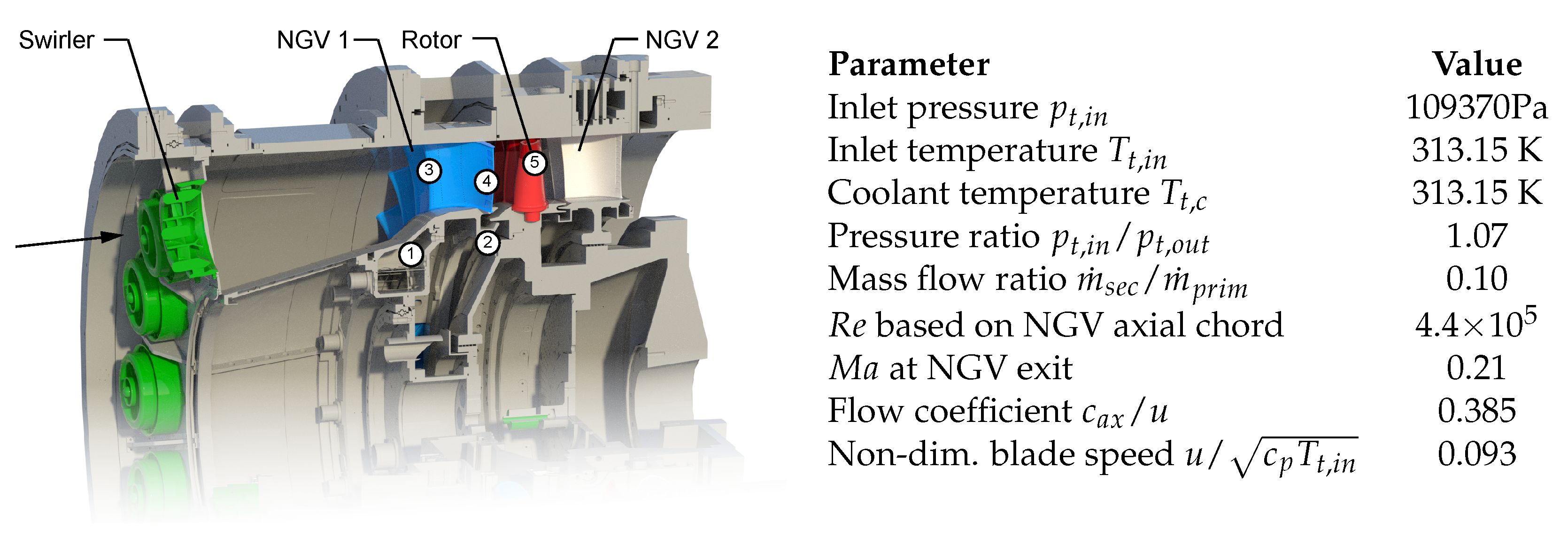
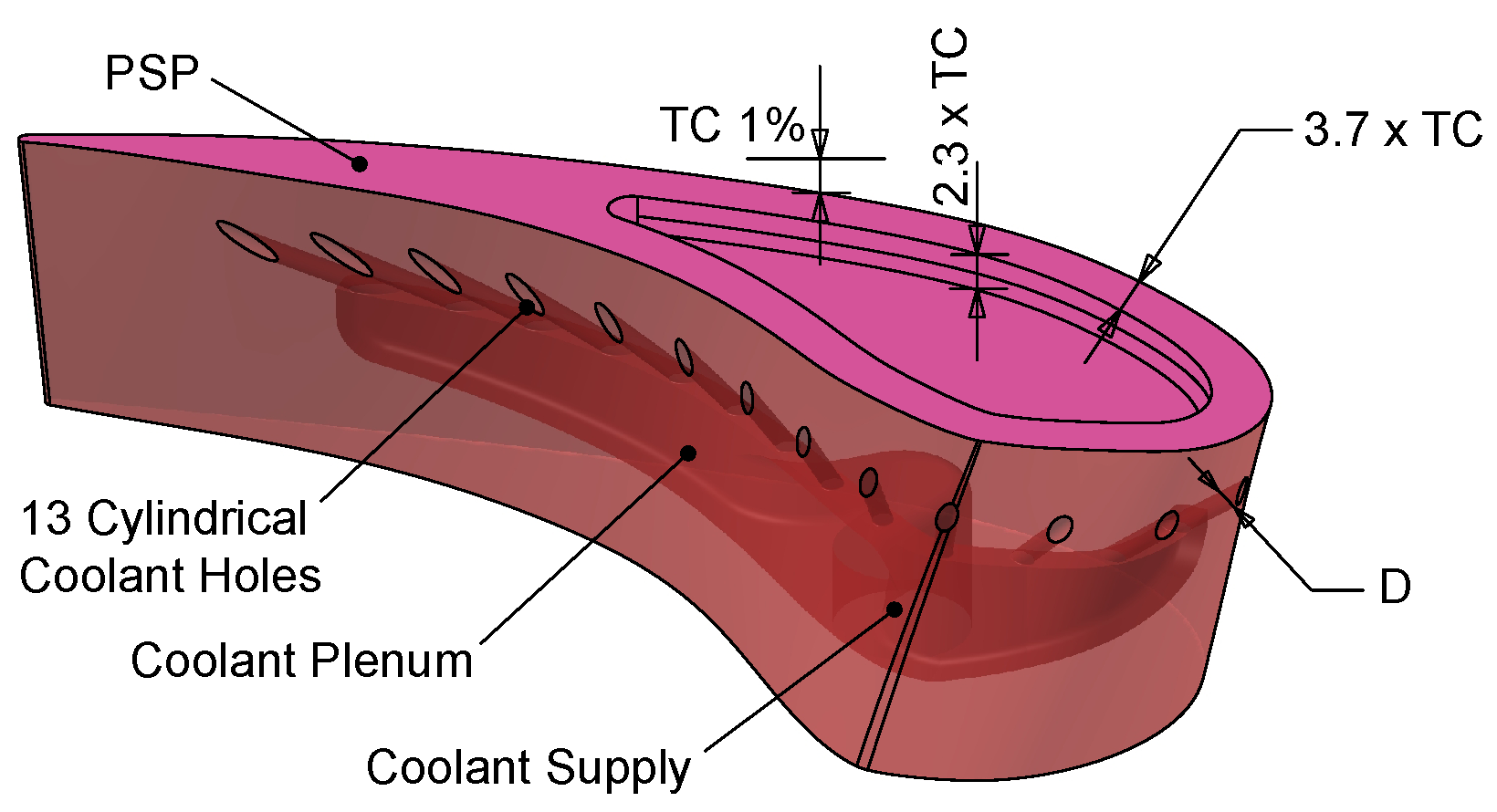
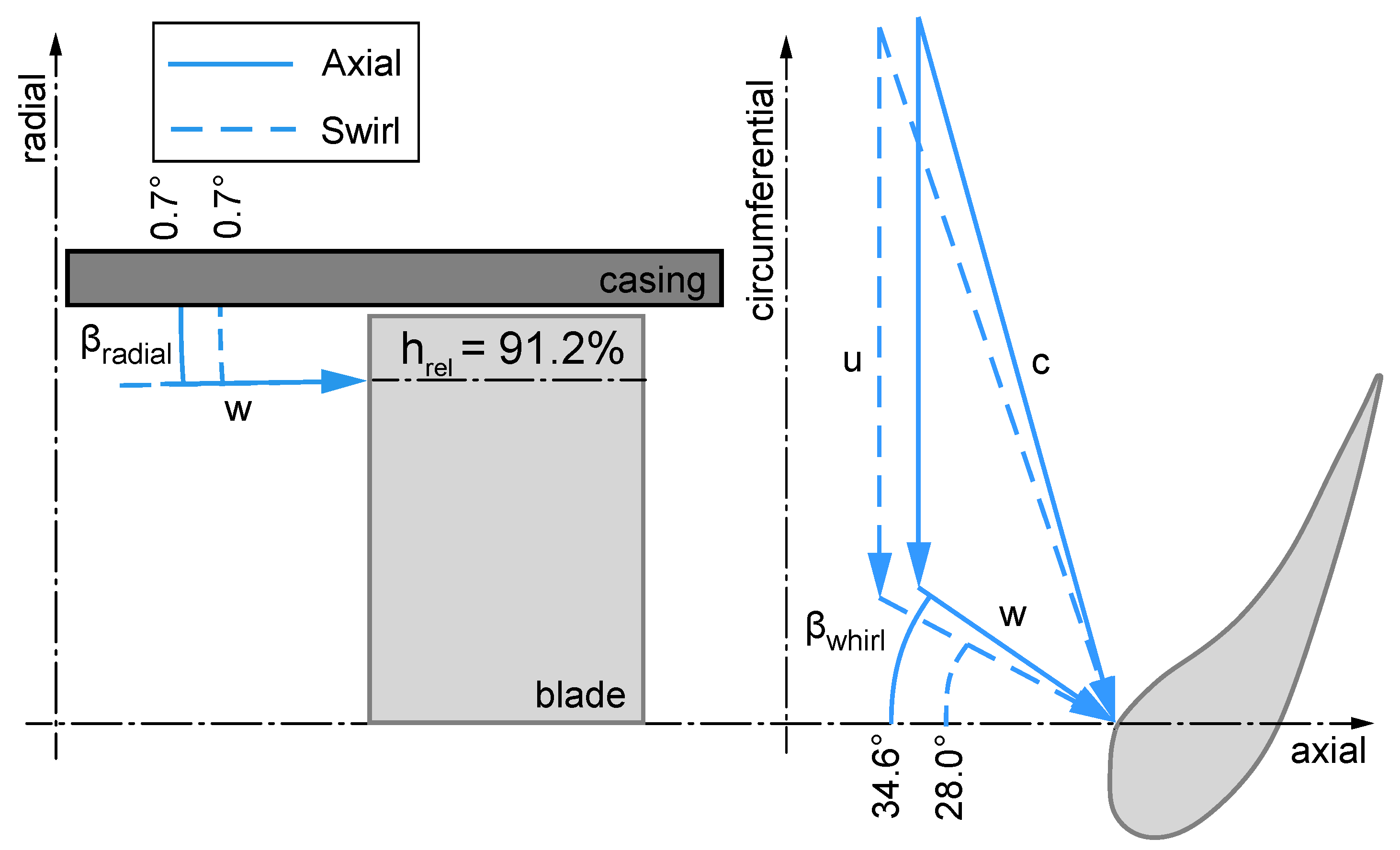
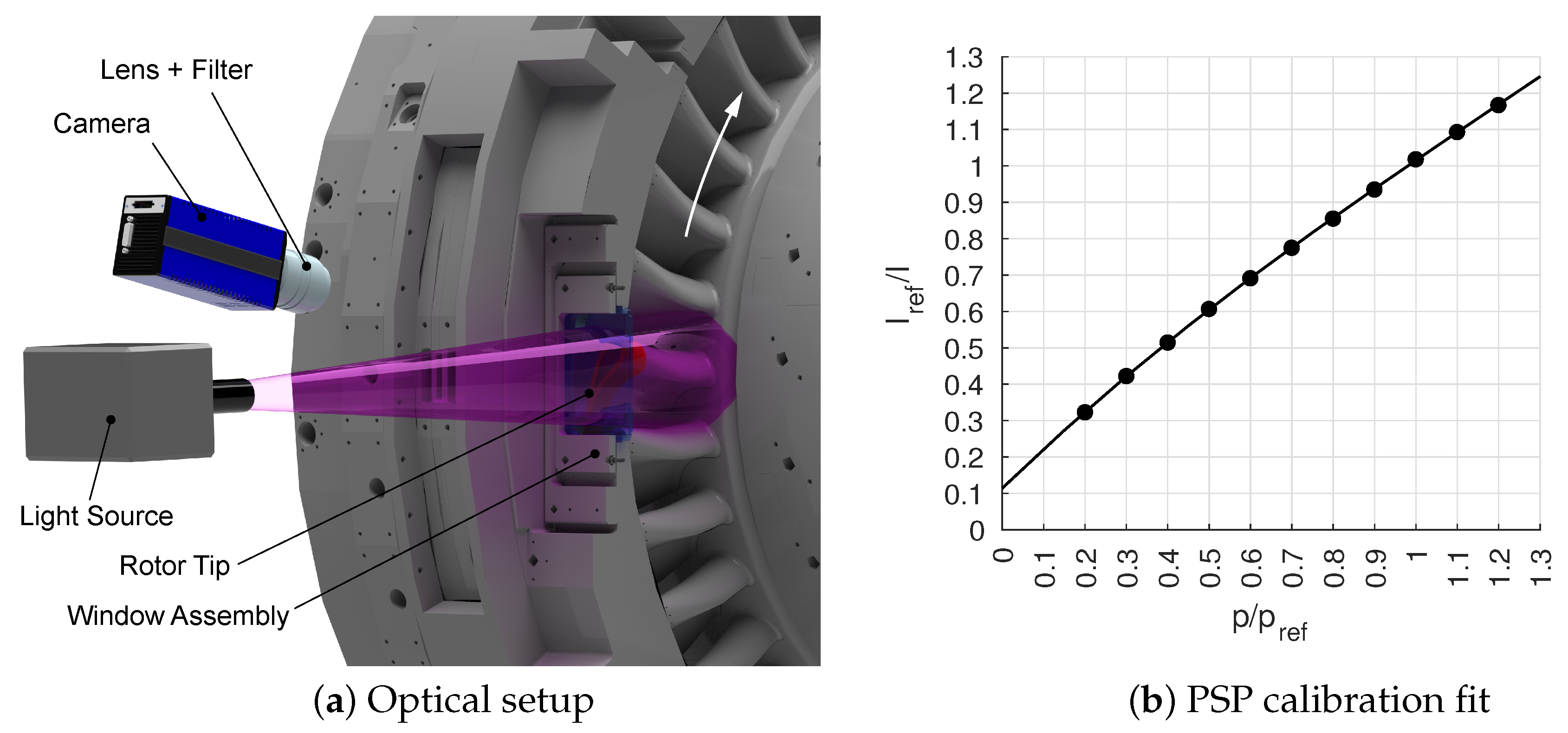
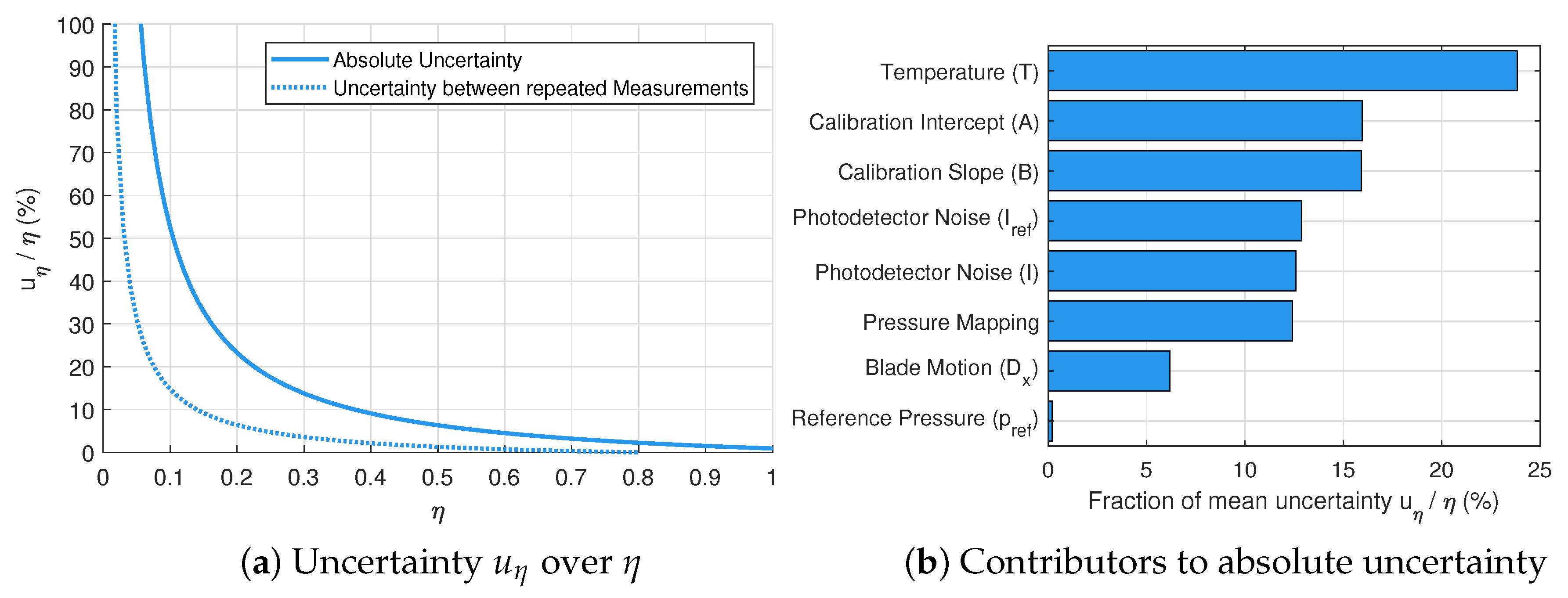

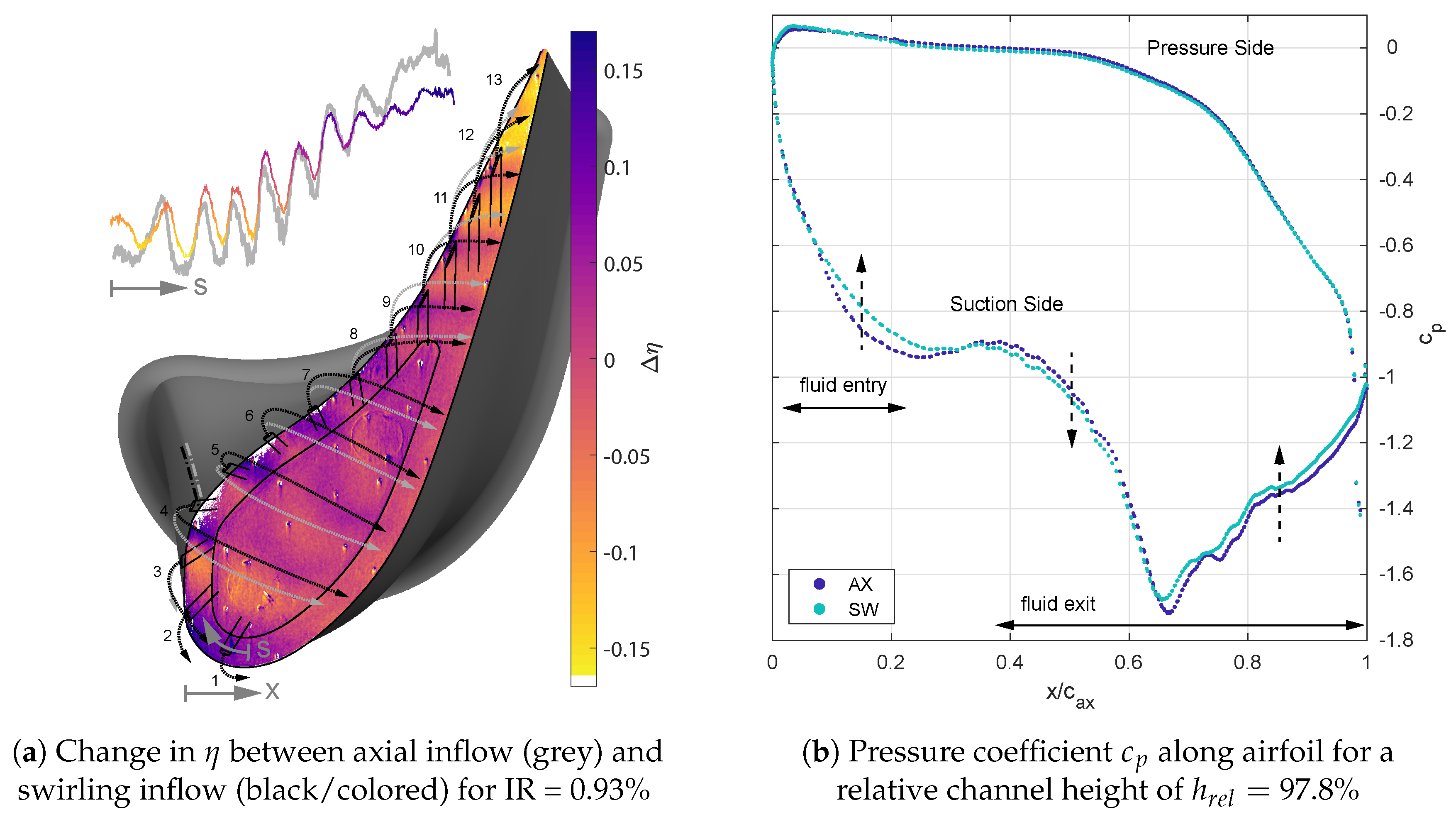
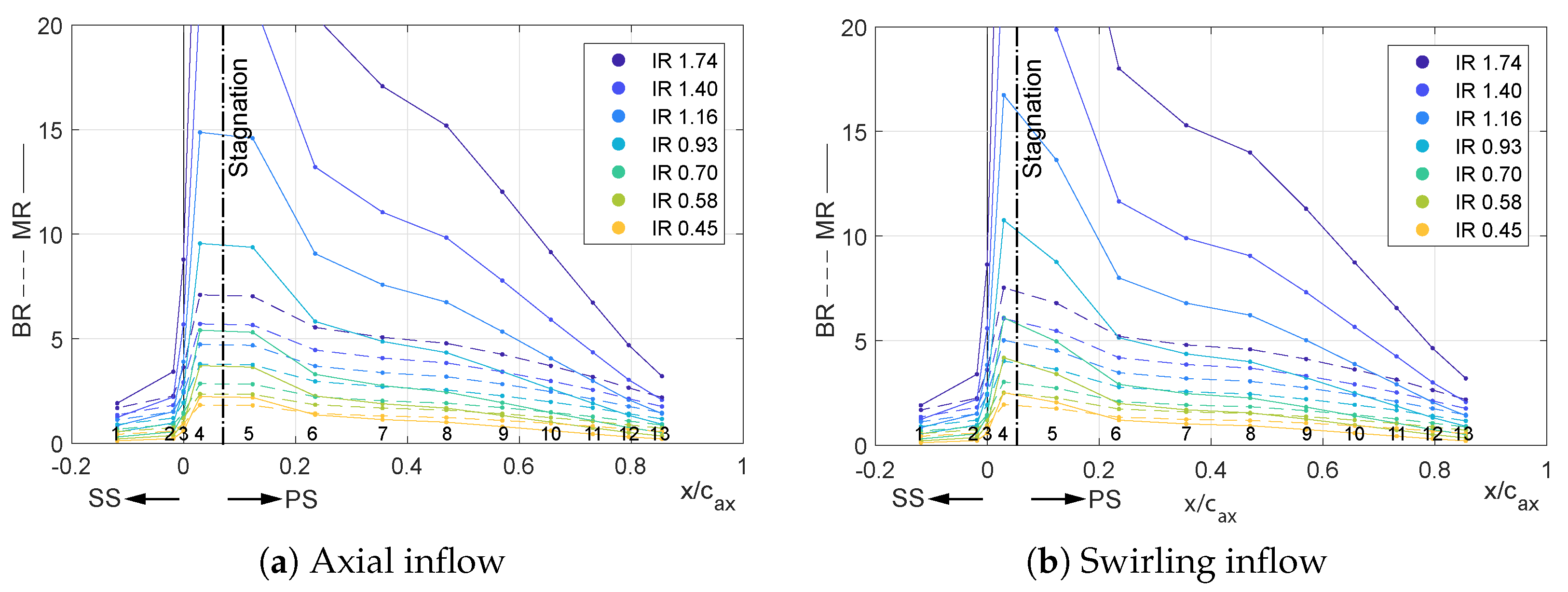

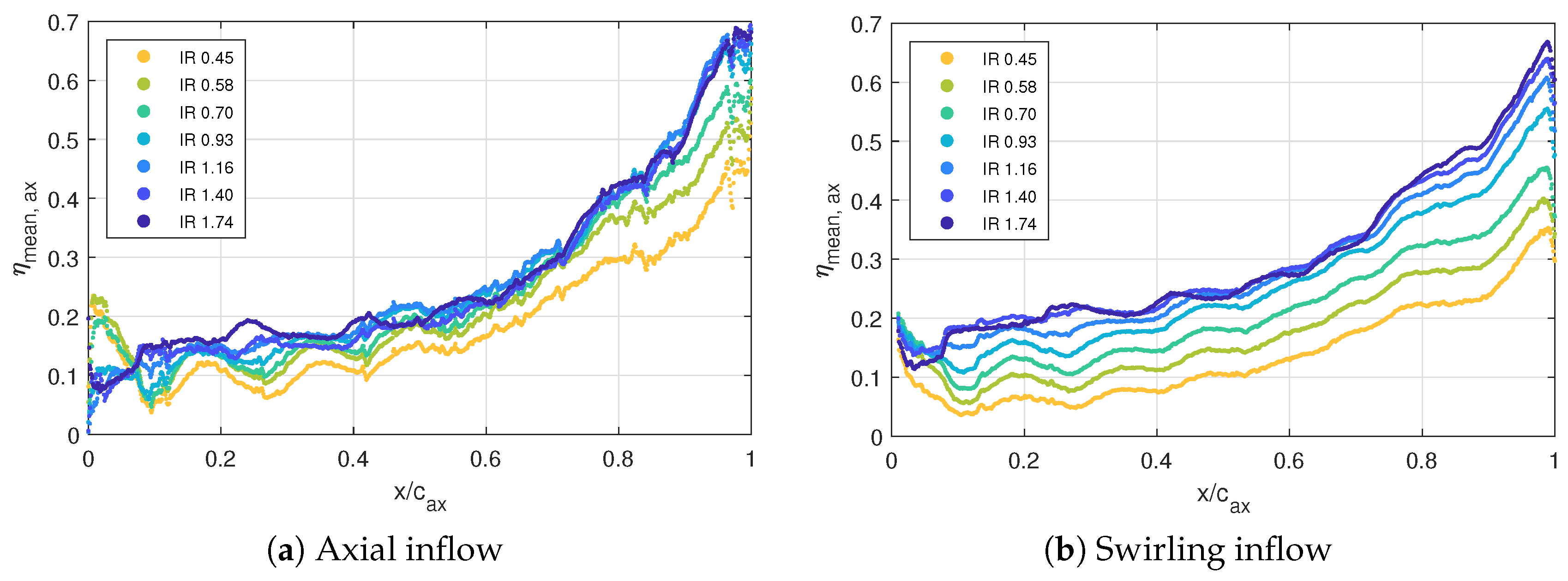
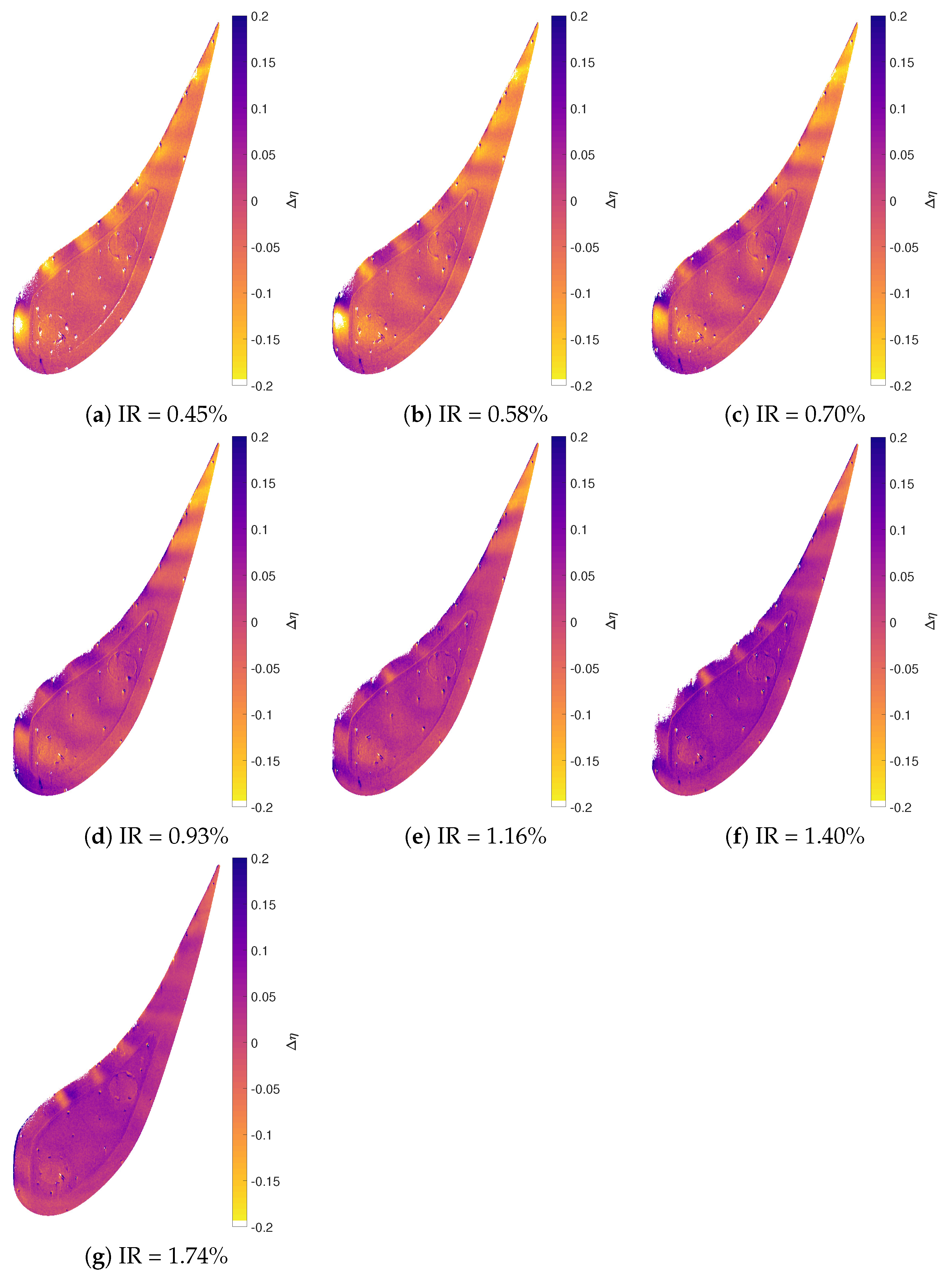
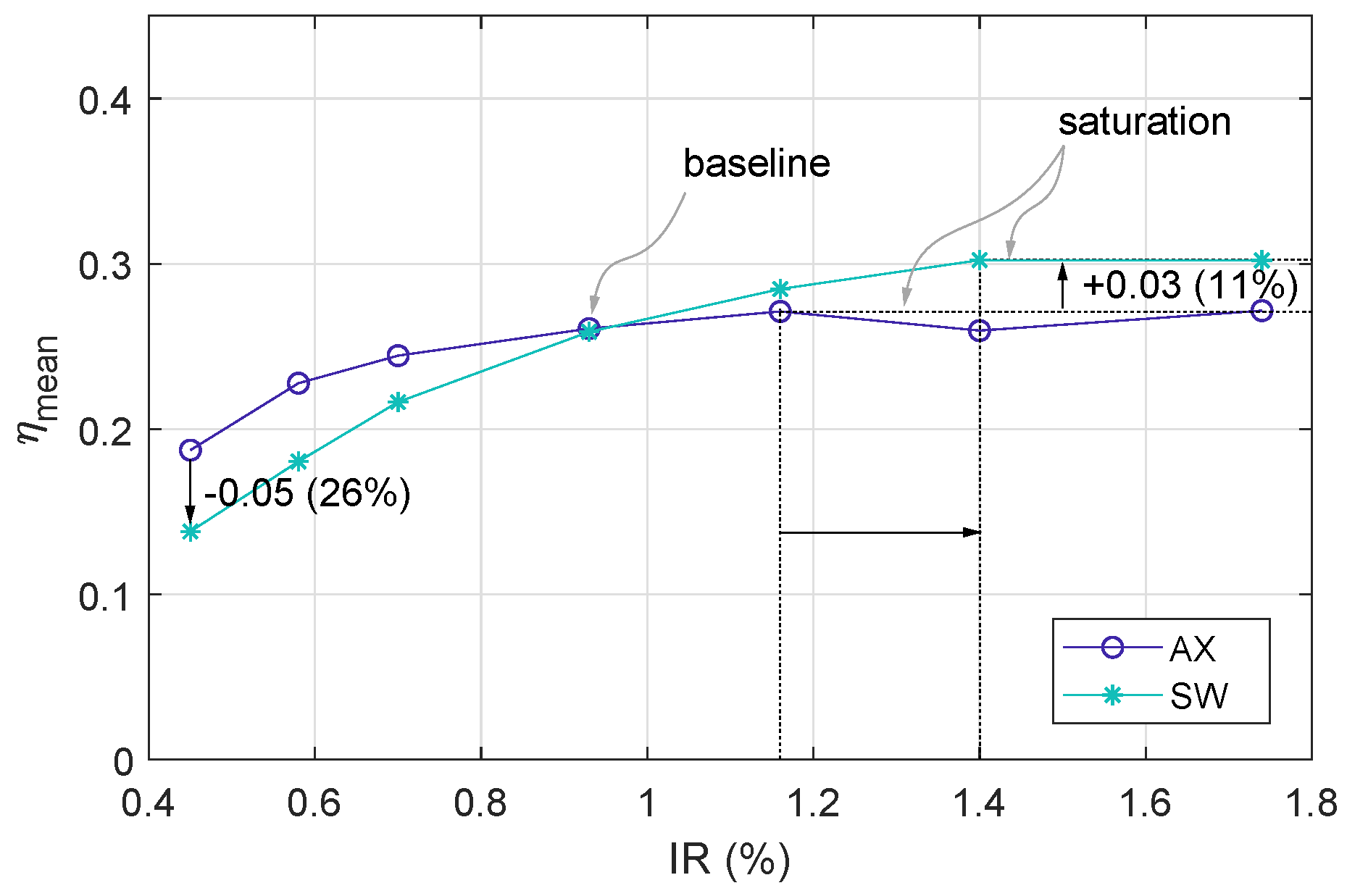
© 2019 by the authors. Licensee MDPI, Basel, Switzerland. This article is an open access article distributed under the terms and conditions of the Creative Commons Attribution (CC BY-NC-ND) license (https://creativecommons.org/licenses/by-nc-nd/4.0/).
Share and Cite
Wilhelm, M.; Schiffer, H.-P. Experimental Investigation of Rotor Tip Film Cooling at an Axial Turbine with Swirling Inflow Using Pressure Sensitive Paint. Int. J. Turbomach. Propuls. Power 2019, 4, 23. https://doi.org/10.3390/ijtpp4030023
Wilhelm M, Schiffer H-P. Experimental Investigation of Rotor Tip Film Cooling at an Axial Turbine with Swirling Inflow Using Pressure Sensitive Paint. International Journal of Turbomachinery, Propulsion and Power. 2019; 4(3):23. https://doi.org/10.3390/ijtpp4030023
Chicago/Turabian StyleWilhelm, Manuel, and Heinz-Peter Schiffer. 2019. "Experimental Investigation of Rotor Tip Film Cooling at an Axial Turbine with Swirling Inflow Using Pressure Sensitive Paint" International Journal of Turbomachinery, Propulsion and Power 4, no. 3: 23. https://doi.org/10.3390/ijtpp4030023
APA StyleWilhelm, M., & Schiffer, H.-P. (2019). Experimental Investigation of Rotor Tip Film Cooling at an Axial Turbine with Swirling Inflow Using Pressure Sensitive Paint. International Journal of Turbomachinery, Propulsion and Power, 4(3), 23. https://doi.org/10.3390/ijtpp4030023




